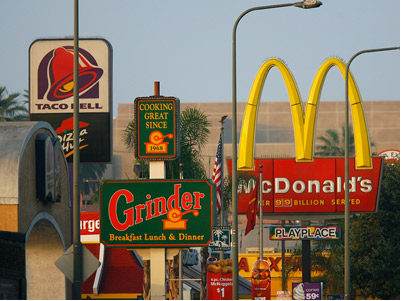What’s a food desert? When I hear the term I think of old Road Runner cartoons or a barren landscape of rocks and sun with a Joshua tree or cactus off in the distance. It’s not the landscape many Angelenos are currently seeing of green hills, lush full trees and wildflowers blooming after a winter that finally freed the state of its drought designation.

But a food desert is also not my image of the sun beating down on the arid land in Twenty Nine Palms or Mojave. In reality it is a common sight here in Los Angeles County. Often a neighborhood and sometimes an entire city, a food desert is a place where you can’t easily find healthy foods because there is little to be had. The good stuff’s not there for a variety of reasons including an absence of stores that carry quality fresh fruit and vegetables at a fair price.
If you want to find the food deserts in L.A. just follow the trash in any of the County’s junk food districts. You can find the desert next to or even inside many South LA convenience stores or at the To Go window at a fast food restaurant in a Baldwin Park or San Fernando mini mall. The soda bottles, candy wrappers, Styrofoam containers and empty chip bags are the telltale signs of the food desert. Like the tumbleweed, shell casings and tin cans of the real desert, junk food containers betray the food wasteland. And they are one big reason why more and more Angelenos young and old alike are struggling today with obesity and diabetes.
(It would be tempting to say that food deserts are brought to you and caused by the people who brought you “The Real Thing.” And in many ways they are, because soda is often the cash cow in fast food establishments. But Coke, Pepsi and Sunkist don’t just want to sell their products in lieu of food in the food desert. They of course want to sell their junk everywhere.)
Whatever the cause or combination of causes, the challenge now is making the food desert bloom with large and small stores that offer quality fruits and vegetables at good prices. The fact is it is often not easy to attract quality markets to poor communities. Sure there is still redlining (the practice by banks of writing off parts of the city to business investment) but sometimes the resistance comes from the small independent storeowners who fear a loss of their livelihood in the arrival of the big players. Acknowledging these concerns and that buying power means everything to a small store owner, if they’re not offering healthy food in their establishments then perhaps they don’t deserve the community’s patronage.
As has been proven in some parts of L.A., the food desert doesn’t have to be our fate forever. Large supermarkets like Food For Less have long demonstrated that poor and working class people will flock to a market that gives them quality at a fair price. And Fresh & Easy, a new arrival in South LA and elsewhere, is demonstrating that healthy markets and the community can coexist.
Farmers markets are another important solution. And best of all, they bring the produce to the community, so you can often walk or bike to them.
These open-air street marts, ideal for the LA climate, create a direct connection between growers and vendors and their customers. So what’s it going to be, another Coke or some fresh fruit picked this morning? Now that’s something we can all call the real thing.
Joel Epstein is a Westside resident, Metro customer, and strategic communications consultant focused on transportation and other critical urban issues. Visit joelepstein.com to learn more.






